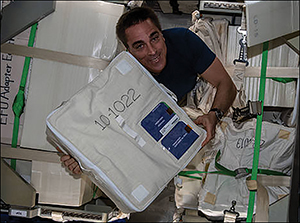Crossref Citations
This article has been cited by the following publications. This list is generated based on data provided by
Crossref.
Campbell, Peter B.
2021.
The Anthropocene, hyperobjects and the archaeology of the future past.
Antiquity,
Vol. 95,
Issue. 383,
p.
1315.
Walsh, Justin St. P.
Gorman, Alice C.
and
Salmond, Wendy
2021.
Visual Displays in Space Station Culture.
Current Anthropology,
Vol. 62,
Issue. 6,
p.
804.
Ali, Rao Hamza
Kashefi, Amir Kanan
Gorman, Alice C.
Walsh, Justin St. P.
and
Linstead, Erik J.
2022.
Automated identification of astronauts on board the International Space Station: A case study in space archaeology.
Acta Astronautica,
Vol. 200,
Issue. ,
p.
262.
Walsh, Justin St P.
Gorman, Alice C.
and
Castaño, Paola
2022.
Postorbital discard and chain of custody: The processing of artifacts returning to Earth from the International Space Station.
Acta Astronautica,
Vol. 195,
Issue. ,
p.
513.
Holcomb, Justin A.
O'Leary, Beth
Darrin, Ann G.
Mandel, Rolfe D.
Kling, Corbin
and
Wegmann, Karl W.
2023.
Planetary geoarchaeology as a new frontier in archaeological science: Evaluating site formation processes on Earth's Moon.
Geoarchaeology,
Vol. 38,
Issue. 5,
p.
513.
Walsh, Justin St. P.
Hamza Ali, Rao
Gorman, Alice C.
and
Kashefi, Amir Kanan
2024.
First Approximation of Population Distributions on the International Space Station.
Journal of Spacecraft and Rockets,
Vol. 61,
Issue. 1,
p.
133.
Gorman, Alice
2024.
Launching archaeology into space and what it tells us about life on earth.
Australian Archaeology,
Vol. 90,
Issue. 1,
p.
39.
Holcomb, Justin A.
O’Leary, Beth L.
Fairén, Alberto G.
Mandel, Rolfe D.
and
Wegmann, Karl W.
2024.
The emerging archaeological record of Mars.
Nature Astronomy,
Vol. 8,
Issue. 12,
p.
1490.
Heras-Bastida, Sergio
2024.
Guo, H., Wang, X., Chen, F. y Wang, C. (2024): Introduction to Space Archaeology. Springer, ISBN 978-981-99-6964-7, 412 páginas. https://doi.org/10.1007/978-981-99-6965-4.
Complutum,
Vol. 35,
Issue. 2,
p.
395.
Walsh, Justin St. P.
Graham, Shawn
Gorman, Alice C.
Brousseau, Chantal
Abdullah, Salma
and
Biehl, Peter F.
2024.
Archaeology in space: The Sampling Quadrangle Assemblages Research Experiment (SQuARE) on the International Space Station. Report 1: Squares 03 and 05.
PLOS ONE,
Vol. 19,
Issue. 8,
p.
e0304229.
Forassiepi, Luca
and
Holcomb, Justin A.
2025.
Planetary Geoarchaeology of Comets: Site Formation Processes on 67P/Churyumov–Gerasimenko.
Geoarchaeology,
Vol. 40,
Issue. 4,
